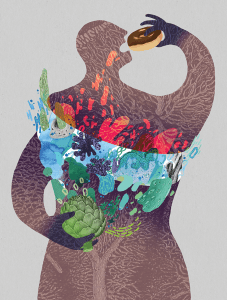Moises Velasquez-Manoff in Nautilus:
 For the microbiologist Justin Sonnenburg, that career-defining moment—the discovery that changed the trajectory of his research, inspiring him to study how diet and native microbes shape our risk for disease—came from a village in the African hinterlands. A group of Italian microbiologists had compared the intestinal microbes of young villagers in Burkina Faso with those of children in Florence, Italy. The villagers, who subsisted on a diet of mostly millet and sorghum, harbored far more microbial diversity than the Florentines, who ate a variant of the refined, Western diet. Where the Florentine microbial community was adapted to protein, fats, and simple sugars, the Burkina Faso microbiome was oriented toward degrading the complex plant carbohydrates we call fiber.
For the microbiologist Justin Sonnenburg, that career-defining moment—the discovery that changed the trajectory of his research, inspiring him to study how diet and native microbes shape our risk for disease—came from a village in the African hinterlands. A group of Italian microbiologists had compared the intestinal microbes of young villagers in Burkina Faso with those of children in Florence, Italy. The villagers, who subsisted on a diet of mostly millet and sorghum, harbored far more microbial diversity than the Florentines, who ate a variant of the refined, Western diet. Where the Florentine microbial community was adapted to protein, fats, and simple sugars, the Burkina Faso microbiome was oriented toward degrading the complex plant carbohydrates we call fiber.
Scientists suspect our intestinal community of microbes, the human microbiota, calibrates our immune and metabolic function, and that its corruption or depletion can increase the risk of chronic diseases, ranging from asthma to obesity. One might think that if we coevolved with our microbes, they’d be more or less the same in healthy humans everywhere. But that’s not what the scientists observed. “It was the most different human microbiota composition we’d ever seen,” Sonnenburg told me. To his mind it carried a profound message: The Western microbiome, the community of microbes scientists thought of as “normal” and “healthy,” the one they used as a baseline against which to compare “diseased” microbiomes, might be considerably different than the community that prevailed during most of human evolution. And so Sonnenburg wondered: If the Burkina Faso microbiome represented a kind of ancestral state for humans—the Neolithic in particular, or subsistence farming—and if the transition between that state and modern Florence represented a voyage from an agriculturalist’s existence to 21st-century urban living, then where along the way had the Florentines lost all those microbes?
More here.
